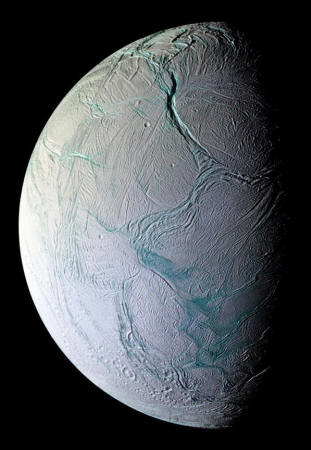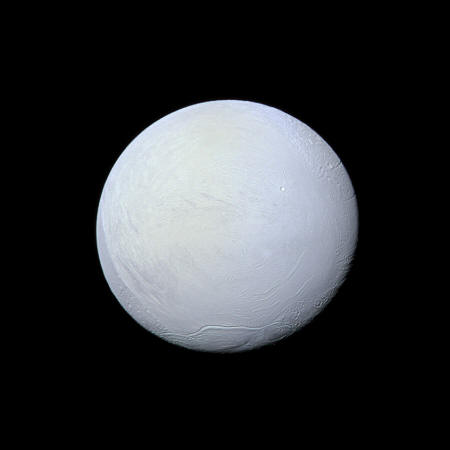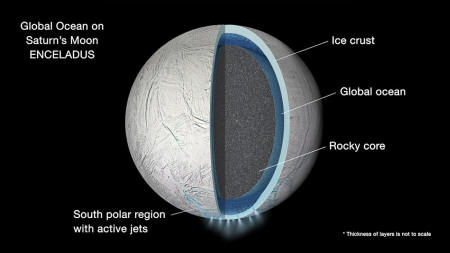|
from LiveScience Website
Saturn's moon Enceladus is an active water world with a global body of water sloshing around deep below its icy crust, scientists have confirmed.
Gorgeous geysers of water have been observed erupting from Enceladus' surface, providing direct evidence of a reservoir of the life-giving liquid below the surface. But scientists were unsure if the satellite contained an entire ocean, or just a small body of water concentrated at its south pole.
The smoking gun is the very slight wobble that Enceladus displays as it orbits Saturn. This unsteady motion is effectively the result of water sloshing around inside Enceladus, and could not appear if the moon were made of ice all the way to its core.
Instead, the moon must contain a complete ocean layer, according to new research that relied on more than seven years of images taken by NASA's Cassini space probe.
Peter Thomas and his colleagues studied images of Enceladus to precisely measure changes in its rotation, then ran several simulations to determine how the interior of the moon would affect those wobbles.
A slight wobble in Saturn's moon Enceladus reveals that the world contains a global ocean beneath its icy crust. Some of this ocean spurts out into space from the southern polar region.
Credit:
NASA/JPL-Caltech/SSI
Wobbly wet moon
Not long after NASA's Cassini mission arrived at Saturn, it detected signs of icy plumes spurting from the southern hemisphere.
Further observation suggested that the fractures at the south pole, dubbed "tiger stripes," were the source of the geysers, allowing material from the interior to leak into space.
Originally, scientists thought only a small local sea existed beneath the icy crust, supplying the plumes with material. Gravitational mapping of the world collected during Cassini's close passes suggested that the sea might be global, but could not be confirmed.
Following an independent line of research, Thomas and his team analyzed more than seven years of images of Enceladus, carefully mapping features on the moon across hundreds of images to measure changes in its rotation. They found that the tiny world has a small but measurable wobble as it orbits the ringed giant Saturn.
The team then ran several simulations to determine how the wobble would affect the moon if it had a variety of interiors, including one that was completely frozen.
They found that the wobble was explained only if Enceladus contained a global ocean beneath its icy crust:
The mystery of Enceladus' ocean
How Enceladus could have maintained a liquid ocean for so long remains a mystery.
Thomas and his colleagues suggested ideas for a future study that might help resolve the question, including the idea that tidal forces produced by the gravity of Saturn could generate more heat within the moon than previously anticipated.
Currently, NASA scientists are considering sending a spacecraft to Enceladus as early as 2021.
The research was published online (Enceladus's Measured Physical Libration Requires a Global Subsurface Ocean) in the journal Icarus.
|





